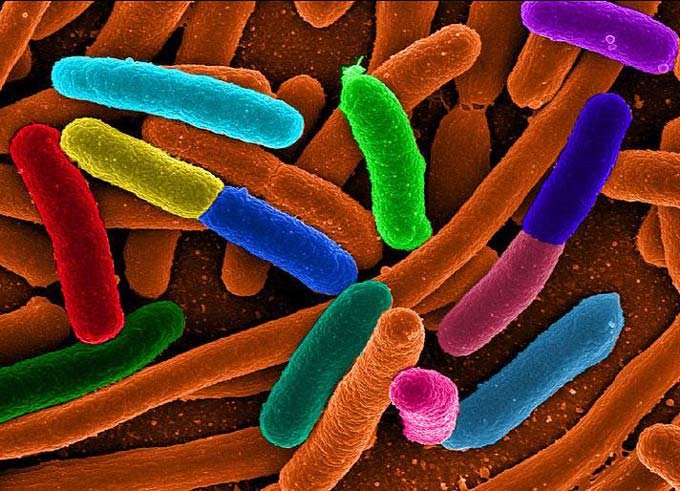Biotium developed PMA dye for viability PCR 12 years ago, an advance that has spawned countless publications and contributed to basic research, diagnostics and food safety. We decided to take a look back on the many uses of PMA and viability PCR over the years.
Goodbye agar plates
The use of a photo-reactive DNA-binding dye to specifically amplify DNA from live bacteria was first reported in 2003 by Nogva et al. (1) who used Ethidium Monoazide (EMA) to inhibit PCR amplification from dead cells in a qPCR assay. Thus viability PCR (v-PCR) was born, allowing scientists for the first time to ditch cumbersome agar plates and quantify bacterial viability more quickly and easily.
Another advance was made a few years later in 2006, when Andreas Nocker at Montana State University and chemists at Biotium collaborated to invent Propidium Monoazide (PMA), which they demonstrated was more effective than EMA in v-PCR (2). EMA is somewhat cell-permeable, and sometimes inhibits PCR from live cell DNA, resulting in false-negatives. PMA is related to Propidium Iodide (PI), and shares its property of good exclusion from live cells.
Bacteria, viruses, yeast, oh my!
Since its invention in 2006, the use of PMA in v-PCR has skyrocketed, from ~ 5 papers in 2007, to more than 50 publications in 2016 alone. Early studies focused on v-PCR in bacteria, validating the procedure in at least 30 different bacterial strains such as: E. coli, Listeria, Legionella, Lactobacillus, M. tuberculosis, Chlamydia, H. pylori, and many other strains with relevance to human health.
v-PCR in microbes gets the most attention, but further studies have shown that PMA is not just for bacteria: there have been dozens of publications using v-PCR in yeast and fungi, more than 30 reported uses in viruses, and several papers in a variety of other cell types such as archaea, amoeba, and parasites. Because membrane integrity is a commonly-used measure of cell viability for most types of cells, PMA is well suited for viability analysis in most cell types, as well.
What do cheese whey and space stations have in common?
Once the v-PCR method was validated in many cell types, it was then applied in the field. PMA has been used in many fascinating applications, such as food testing (lettuce, asparagus, cherries, cheese, meat, pickles, milk, yogurt, seafood and baby formula, to name a few) and environmental testing (such as seawater, freshwater, wastewater, sand, piggery effluent, Mars habitat, International Space Station and arctic core samples).
A typical v-PCR experiment involves PMA pre-treatment followed by photoactivation and then a qPCR reaction, which can be done using a qPCR dye such as EvaGreen® or probe-based PCR. However some enterprising researchers have combined PMA pretreatment with other analytical methods, such as Loop-Mediated Isothermal Amplification (LAMP), 454 pyrosequencing, Illumina sequencing, and metagenomic analysis. PMA used in combination with the deep sequencing and metagenomic analyses offers an exciting way to quantify and analyze large and potentially unknown populations in a single experiment.
PMAxx™ and other fun stuff
Biotium is the inventor and main supplier of PMA dye worldwide. In 2016 the newest advance in v-PCR was made with the invention by Biotium of PMAxx™, a new and improved v-PCR dye. PMAxx™ shows improvements over PMA in all bacterial strains tested so far and has been shown to work well with Norovirus (3) and Hepatitis A Virus (4). PMAxx™ therefore has the potential to become the next gold standard for v-PCR experiments. We also offer the most v-PCR accessory products such as the PMA-Lite֭™ and Glo-Plate Blue™ for photo-activation, PMA Enhancer for gram-negative bacteria, and a series of bacterial species-specific viability PCR kits.
Looking forward from 2018, Biotium continues innovating and expanding our line of v-PCR and other viability reagents to continue supporting these diverse research efforts.
Cited References
- Nogva et al. Biotechniques. 2003 Apr;34(4):804-8, 810, 812-3.
- Nocker et al. J Microbiol Methods. 2006 Nov;67(2):310-20.
- Randazzo et al. Int J Food Microbiol. 2016 Jul 16;229:1-6.
- Randazzo et al. J Appl Microbiol. 2018 Apr;124(4):958-964.
Click here to see a list of publications using PMA or PMAxx™ in a variety of cell types and applications.






